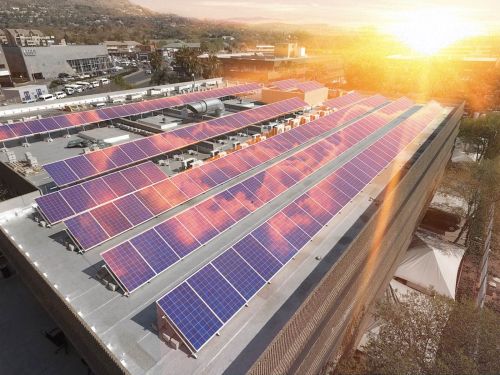
Image: SolarEdge.
The variable weather in the UK is a favourite topic of conversation, but when it comes to solar installations it is also be a key consideration for the efficiency and durability of a site.
Speaking to Solar Power Portal recently, SolarEdge’s UK country manager Christelle Barnes said there are two key weather issues; how it will impact the amount of power a system can produce, and whether the individual components are robust enough to withstand the effects of bad weather.
“The weather in the UK can be extremely changeable – warm and sunny one day and raining and windy the next. It is therefore important to choose a technology that can deliver the maximum power output even when conditions are less than optimum,” she said.
“For example, even intermittent cloud cover can significantly decrease power production in traditional string inverter systems. This is because of the energy mismatch that occurs when modules operate at different efficiencies. As traditional string inverter systems require solar modules to be wired in a series, if a single module’s output is affected, the efficiency of the entire string is reduced.”
This issue can be prevented by installing a PV solution that tracks system performance at a module level. This allows each module to work at its own maximum power point, ensuring that unlike traditional systems, if the performance of a few panels is reduced, the rest of the system continues to operate at maximum capacity.
Solar ‘nowcasting’ could further aid this optimisation in the future, with non-profit Open Climate Fix having received a two year grant from Google.org of £500,000 earlier this year to develop a transformer model to more accurately forecast cloud formations, and ultimately levels of solar irradiation. With better forecasting of irradiation, solar farm operators may be able to further optimise performance through panel tracking and positioning.
Currently, PV equipment should be able to operate across a wide ambient temperature range, as great as -40°C to 60°C for inverters and as hot as 85°C for rooftop equipment. But there are still key precautions necessary to prepare for extreme weather, continued Barnes.
“Materials development is one factor paving the way for more robust solar installations. A great example of this is the growing adoption of split-cell technology in solar modules. Split-cell solar panels are smaller in size than their traditional counterparts and are therefore more resistant to cracking.”
By contrast, large-format modules can be at particular risk of cracking due to things like hail or being hit by debris during windy periods, given their larger surface area and thinner glass.
Testing is key: from heat to humidity
In order to ensure solar equipment can withstand whatever the weather throws at it, rigorous testing must take place. At SolarEdge for example, all its electrical equipment undergoes thermal cycling tests of up to 1,500 cycles at temperatures from -40°C to 80°C.
“Another important test is the Burn-In test, which accelerates the product lifetime to verify that equipment meets life expectancy and performance goals,” said Barnes. “For instance, an HTOL (high temperature operating Life) test that we consider important is a moderate climate scenario that is the equivalent to more than 35 years. This test assesses electrical equipment at 125°C to verify that product lifetime is within expectations. These tests specifically relate to product operation in different temperatures; however, there are other environmental conditions that can impact PV product operation.”
Other key considerations for solar equipment manufacturers in the UK are humidity and saline conditions, in particular if the installations will be sited new a coastline. In such a case, PV equipment must be designed from the outset to withstand humid environmental conditions and thoroughly tested, said Barnes.
“Products need to be properly sealed and use non-corrosive material to operate at high humidity levels of up to 95% (non-condensing). As part of testing, PV equipment should undergo damp heat tests at 85°C/85% RH for 1,200 hours which is equivalent to nearly 28 years in the field. In terms of saline, PV equipment should be warranted for installation at any distance from the ocean or other saline environments, as long as there are no direct salt-water splashes.”
For more on how to protect a solar PV system from the weather, see our full length feature Extreme weather protection: How to ‘weatherise’ a solar installation in the most recent version of PV Tech Power.

